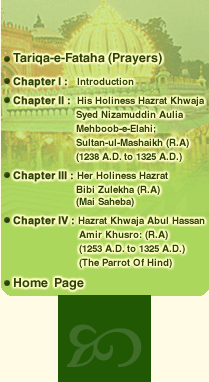|
6.
Homage and Worship
Historian writer Farishta narrates in his
book, "Tareekh Farishta" that when Hassan Gangu, who later
established Bahmani Sultanate in Deccan approached His Holiness
Sultan-ul-Mashaikh; Mehboob-e-Elahi (R.A) with his destitutes,
His Holiness gave him a piece of bread roofing on the tip
of his finger and told:
"Hassan, this is the roof of your Sultanate, destined
to you in Deccan."
The historian further states that when
Hassan Gangu became the King, he gave five munds of Gold and
ten munds of silver as ‘Nazrana’ through Hazrat Khwaja Burhanuddin
Ghareeb (R.A) to distribute among poor in favour of His Holiness
blessings. Mohd. Bin Tughlak constructed a tomb on His Holy
shrine. Feroze Shah installed carved doors, grilled sandal
walls and golden lanterns for the tomb. Timur on reaching
Delhi visited the shrine. Babur who laid the foundation of
the Mughal Empire, visited and paid homage to His Holiness
many times. Akbar and Shahjahan also visited the Holy Shrine
of His Holiness umpteen times. Shahjahan built the marble
screen and popular jali around the courtyard of the Shrine.
Jahan Ara the beautiful princess and the daughter of Shahjahan
use to visit the Holy Shrine very often. She with her long
silky hairs used to clean and sweep the dust of the darbar
with her long silken hair. She finally selected her last resting
place at the feet of His Holiness Mehboob-e-Elahi.
For the last eight hundred odd years,
Royals, commoners, scholars, saints, poor and downtrodden
have found His Holiness darbar a gracious shelter. Delhi saw
many upheavals and revolutions, but the grandeur of this Holy
Shrine of His Holiness Sultan-ul-Mashaikh; Mehboob-e-Elahi
(R.A) remains a central foundation for spiritual peace for
all people.
Hazrat Amir Khusro says:
"You cannot earn wealth and status by worshipping the
King like a dog. Be at the service of dervish, for this
is a more respectable way of reaching glory."
"Tu an shah-e-ke-bar aiwane-e-qasrat, kabutar gar nashinad
baz gardad…"
(You are such a mighty King that if a pigeon
sits on your palace, it turns into a hawk.)
Hazrat Amir Khusro (R.A) in his deep love
further says:
"Her qaum rast rahe, dine, Va qibla gahe, Man Qibla
ras Karden bar, tarf kaj Kulahe."
(Every race has their own religion and object
of worship. I have my Qibla (His Holiness Sultan-ul-Mashaikh)
who wears an inclined cap and I am submitting my reverence
to him.)
 -
Swami Sivananda -
Swami Sivananda
- Life
History
- Spiritual
Lustre of His Holiness
- Spiritual
Principles and Khilafat Namah from Hazrat Baba Fariduddin Ganj Shakar (R.A)
- Glories
of His Holiness
- The
Curtain Falls
- Homage
and Worship
- Disciples
and Descendants of His Holiness Hazrat Sultan-ul- Mashaikh (R.A)
- WORKS
- Divine
Graces of His Holiness Sultan-ul-Mashaikh (R.A.)
-
10 (a) MUNAJATH (Dua) in the Darbar of His Holiness Mehboob-e-Elahi; Sultan-ul-Mashaikh
(R.A)
10 (b) Munajat (Sunset Prayers)
- Ten
Tasbihs of His Holiness for Peace & Successful Life
|





